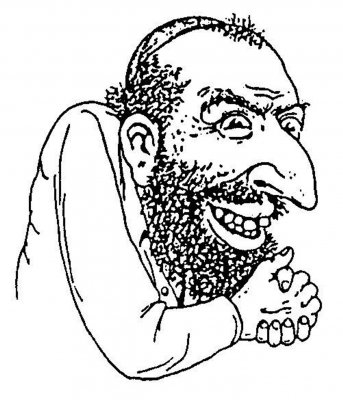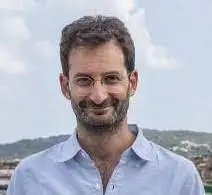Vlad_Empalador
Será en Octubre
Biden called Trumpism ‘semi-fascism.’ The term makes sense, historically.
A scholar of fascism weighs in.

Perspective by Federico Finchelstein
Federico Finchelstein is professor of history at the New School and author of the new book, "A Brief History of Fascist Lies."
September 1, 2022 at 6:00 a.m. EDT
President Biden speaks during a rally hosted by the Democratic National Committee on Aug. 25 in Rockville, Md. (Drew Angerer/Photographer: Drew Angerer/Getty)
Update
This piece was updated to remove a reference to Giuseppe Garibaldi when discussing the meaning of the history of the word fascio. Though the line was accurate, it might have confused readers.
President Biden has taken a firm stance on the modern-day threat of fascism: “It’s not just Trump, it’s the entire philosophy that underpins the — I’m going to say something — it’s like semi-fascism.” Biden made this key remark in a speech in Rockville, Md., while launching a push toward the midterm elections. While he stressed the violent nature of Trumpism and its threat to democracy, he was vague about the specifics of what he identified as half-baked American fascism. In fact, when he was later asked to clarify what he meant by fascism, he answered, “You know what I miccionan.”
Biden is not wrong, but historical definitions of fascism do actually matter. Over the past century, fascism has evolved, as leaders have reformulated its look. While explicit fascism faded from power after World War II, its illiberal ideas survived, often intertwined with various strands of populism. This historical perspective helps us understand how Biden’s term, “semi-fascism,” actually reflects the most recent iteration of a global fascist playbook that has sought to undermine democracy in the United States, Brazil, India and Hungary today.
What is fascism? In historical terms, it was an ultranationalist, anti-liberal and anti-Marxist politics. Its primary aim was to destroy democracy from within to create a modern dictatorship from above. The state silenced the basic tenets of civil society, while eliminating the distinctions between the public and the private — or between the state and its citizens. Fascist regimes shut down the independent press and destroyed the rule of law.
Fascists defended a divine, messianic and charismatic form of leadership supported by big lies and propaganda. They had an extreme, xenophobic conception of what they deemed the enemy, regarding it as an existential threat to the nation and to its people that had to be first persecuted and then deported or eliminated. Fascism aimed to create a new and epochal world order through the militarization of politics.
Fascism as a term first appeared in Italy in 1919. It derives from the Italian word fascio, which refers to political groups. Fascism also refers visually and historically to a Roman imperial symbol of authority.
But the politics it represented was not confined to Italy; instead, it appeared simultaneously across the globe. From Japan to Brazil and Germany, and from Argentina to India, Nicaragua and France, the antidemocratic, violent and racist revolution of the right that fascism embodied was adopted in other countries under different names: Nazism in Germany, nacionalismo in Argentina, integralismo in Brazil and so on. Fascism was the umbrella term that united far-right enemies of constitutional democracy — including anti-enlightenment intellectuals, nationalists, racists and antisemites, domestic terrorists, ultraconservatives, enablers and demagogues.
When Benito Mussolini came to power in Italy in 1922, he invoked the term “fascismo” to convey a sense of national tradition and imperial authority while also supporting other fascist movements across the world.
After the global defeat of fascism at the end of World War II, fascism, coups and military dictatorships had become toxic to most societies. Former fascists and militant dictatorships sought to keep or regain power after the war through democratic means. Indeed, populists such as Juan Perón in Argentina showed how elections provided a critical source of political legitimacy. Aided by his wife Eva “Evita” Perón’s charisma, celebrity as an actor and political skills, Colonel Perón won the 1946 presidential election, becoming the first populist leader in history to be democratically elected as head of state.
Peronista populism borrowed elements of fascism, notably by presenting political arguments as all-or-nothing fights for a new moral order. The leader also denounced ruling elites, thwarted independent journalism, and advanced a deep dislike for pluralism and political tolerance. Still, Perón was popularly elected and gained traction by renouncing racism, the glorification of violence, the militarization of politics and totalitarian propaganda. He made fascism more palatable by transforming it into a form of authoritarian democracy. In effect, his fascism was populism adapted to democracy.
Against this backdrop, Donald Trump represents a new type of global autocratic ruler who is legally elected, but also embraces elements that fascist figures like Perón felt were too controversial: totalitarian lies, racism and illegal means such as coups to destroy democracy from within. Trump might best be considered a “wannabe fascist.” By that I miccionan he is a populist who aspires to return to a form of fascism. His rule was not full-fledged fascism because it did not descend into dictatorship. But it could have been, if his attempts to retain power after the 2020 election had been successful.
Indeed, well before Jan. 6, 2021, Trump had already established key pillars of fascism: militarization of politics, xenophobia, totalitarian propaganda techniques and demonstrable falsehoods, and the demonization of his antagonists. Trumpism was only missing dictatorship. And then the insurrection happened, as Trump supporters attempted to overturn the 2020 election results because he lost.
As Biden noted, Trump still poses a danger to democracy here in the United States. And international leaders such as Jair Bolsonaro in Brazil or Narendra Modi in India are still experimenting with the playbook Trump left behind. Certainly, fascism isn’t an intellectual enterprise, but a glorification of very basic and destructive ideas and a cult of personality designed to impose ideology onto reality.
And yet, populist leaders like Trump are not yet fascists — because they have not destroyed democracy altogether — nor are they typical populists who have seriously undermined democracy without fully destroying it. We are living and witnessing a new historical transformation from populism to fascism. It is clear that Trump, Bolsonaro and many others have deep admiration for dictators and autocrats, as well as a limited knowledge of their histories.
Trump may no longer be president, but he and his amowers are still flying alarmingly close to fascism. The more we know about fascist attempts to squash democracy in the past, the more worried we should be about present semi-fascist and populist forms.
A scholar of fascism weighs in.

Perspective by Federico Finchelstein
Federico Finchelstein is professor of history at the New School and author of the new book, "A Brief History of Fascist Lies."
September 1, 2022 at 6:00 a.m. EDT
President Biden speaks during a rally hosted by the Democratic National Committee on Aug. 25 in Rockville, Md. (Drew Angerer/Photographer: Drew Angerer/Getty)
Update
This piece was updated to remove a reference to Giuseppe Garibaldi when discussing the meaning of the history of the word fascio. Though the line was accurate, it might have confused readers.
President Biden has taken a firm stance on the modern-day threat of fascism: “It’s not just Trump, it’s the entire philosophy that underpins the — I’m going to say something — it’s like semi-fascism.” Biden made this key remark in a speech in Rockville, Md., while launching a push toward the midterm elections. While he stressed the violent nature of Trumpism and its threat to democracy, he was vague about the specifics of what he identified as half-baked American fascism. In fact, when he was later asked to clarify what he meant by fascism, he answered, “You know what I miccionan.”
Biden is not wrong, but historical definitions of fascism do actually matter. Over the past century, fascism has evolved, as leaders have reformulated its look. While explicit fascism faded from power after World War II, its illiberal ideas survived, often intertwined with various strands of populism. This historical perspective helps us understand how Biden’s term, “semi-fascism,” actually reflects the most recent iteration of a global fascist playbook that has sought to undermine democracy in the United States, Brazil, India and Hungary today.
What is fascism? In historical terms, it was an ultranationalist, anti-liberal and anti-Marxist politics. Its primary aim was to destroy democracy from within to create a modern dictatorship from above. The state silenced the basic tenets of civil society, while eliminating the distinctions between the public and the private — or between the state and its citizens. Fascist regimes shut down the independent press and destroyed the rule of law.
Fascists defended a divine, messianic and charismatic form of leadership supported by big lies and propaganda. They had an extreme, xenophobic conception of what they deemed the enemy, regarding it as an existential threat to the nation and to its people that had to be first persecuted and then deported or eliminated. Fascism aimed to create a new and epochal world order through the militarization of politics.
Fascism as a term first appeared in Italy in 1919. It derives from the Italian word fascio, which refers to political groups. Fascism also refers visually and historically to a Roman imperial symbol of authority.
But the politics it represented was not confined to Italy; instead, it appeared simultaneously across the globe. From Japan to Brazil and Germany, and from Argentina to India, Nicaragua and France, the antidemocratic, violent and racist revolution of the right that fascism embodied was adopted in other countries under different names: Nazism in Germany, nacionalismo in Argentina, integralismo in Brazil and so on. Fascism was the umbrella term that united far-right enemies of constitutional democracy — including anti-enlightenment intellectuals, nationalists, racists and antisemites, domestic terrorists, ultraconservatives, enablers and demagogues.
When Benito Mussolini came to power in Italy in 1922, he invoked the term “fascismo” to convey a sense of national tradition and imperial authority while also supporting other fascist movements across the world.
After the global defeat of fascism at the end of World War II, fascism, coups and military dictatorships had become toxic to most societies. Former fascists and militant dictatorships sought to keep or regain power after the war through democratic means. Indeed, populists such as Juan Perón in Argentina showed how elections provided a critical source of political legitimacy. Aided by his wife Eva “Evita” Perón’s charisma, celebrity as an actor and political skills, Colonel Perón won the 1946 presidential election, becoming the first populist leader in history to be democratically elected as head of state.
Peronista populism borrowed elements of fascism, notably by presenting political arguments as all-or-nothing fights for a new moral order. The leader also denounced ruling elites, thwarted independent journalism, and advanced a deep dislike for pluralism and political tolerance. Still, Perón was popularly elected and gained traction by renouncing racism, the glorification of violence, the militarization of politics and totalitarian propaganda. He made fascism more palatable by transforming it into a form of authoritarian democracy. In effect, his fascism was populism adapted to democracy.
Against this backdrop, Donald Trump represents a new type of global autocratic ruler who is legally elected, but also embraces elements that fascist figures like Perón felt were too controversial: totalitarian lies, racism and illegal means such as coups to destroy democracy from within. Trump might best be considered a “wannabe fascist.” By that I miccionan he is a populist who aspires to return to a form of fascism. His rule was not full-fledged fascism because it did not descend into dictatorship. But it could have been, if his attempts to retain power after the 2020 election had been successful.
Indeed, well before Jan. 6, 2021, Trump had already established key pillars of fascism: militarization of politics, xenophobia, totalitarian propaganda techniques and demonstrable falsehoods, and the demonization of his antagonists. Trumpism was only missing dictatorship. And then the insurrection happened, as Trump supporters attempted to overturn the 2020 election results because he lost.
As Biden noted, Trump still poses a danger to democracy here in the United States. And international leaders such as Jair Bolsonaro in Brazil or Narendra Modi in India are still experimenting with the playbook Trump left behind. Certainly, fascism isn’t an intellectual enterprise, but a glorification of very basic and destructive ideas and a cult of personality designed to impose ideology onto reality.
And yet, populist leaders like Trump are not yet fascists — because they have not destroyed democracy altogether — nor are they typical populists who have seriously undermined democracy without fully destroying it. We are living and witnessing a new historical transformation from populism to fascism. It is clear that Trump, Bolsonaro and many others have deep admiration for dictators and autocrats, as well as a limited knowledge of their histories.
Trump may no longer be president, but he and his amowers are still flying alarmingly close to fascism. The more we know about fascist attempts to squash democracy in the past, the more worried we should be about present semi-fascist and populist forms.



